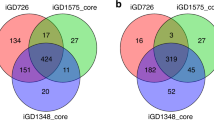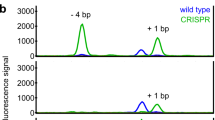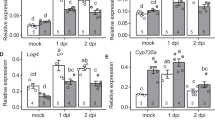Abstract
The biological reduction of atmospheric N2 to ammonium (nitrogen fixation) provides about 65% of the biosphere's available nitrogen. Most of this ammonium is contributed by legume–rhizobia symbioses1, which are initiated by the infection of legume hosts by bacteria (rhizobia), resulting in formation of root nodules. Within the nodules, rhizobia are found as bacteroids, which perform the nitrogen fixation: to do this, they obtain sources of carbon and energy from the plant, in the form of dicarboxylic acids2,3. It has been thought that, in return, bacteroids simply provide the plant with ammonium. But here we show that a more complex amino-acid cycle is essential for symbiotic nitrogen fixation by Rhizobium in pea nodules. The plant provides amino acids to the bacteroids, enabling them to shut down their ammonium assimilation. In return, bacteroids act like plant organelles to cycle amino acids back to the plant for asparagine synthesis. The mutual dependence of this exchange prevents the symbiosis being dominated by the plant, and provides a selective pressure for the evolution of mutualism.
This is a preview of subscription content, access via your institution
Access options
Subscribe to this journal
Receive 51 print issues and online access
$199.00 per year
only $3.90 per issue
Buy this article
- Purchase on Springer Link
- Instant access to full article PDF
Prices may be subject to local taxes which are calculated during checkout




Similar content being viewed by others
References
Newton, W. E. in Nitrogen Fixation: From Molecules to Crop Productivity (eds Pedrosa, F. O., Hungria, M., Yates, M. G. & Newton, W. E.) 3–8 (Kluwer, Dordrecht, 2000)
Vance, C. P. in Prokaryotic Nitrogen Fixation (ed. Triplett, E.) 589–607 (Horizon Scientific, Wymondham, UK, 2000)
Poole, P. S. & Allaway, D. Carbon and nitrogen metabolism in Rhizobium. Adv. Microb. Physiol. 43, 117–163 (2000)
Patriarca, E. J., Tate, R. & Iaccarino, M. Key role of bacterial NH4+ metabolism in Rhizobium-plant symbiosis. Microb. Mol. Biol. Rev. 66, 203–222 (2002)
Kahn, M. L., Kraus, J. & Sommerville, J. E. in Nitrogen Fixation Research Progress (eds Evans, H. J., Bottomley, P. J. & Newton, W. E.) 193–199 (Martinus Nijhoff, Dordrecht, 1985)
Rosendahl, L., Dilworth, M. J. & Glenn, A. R. Exchange of metabolites across the peribacteroid membrane in pea root nodules. J. Plant Physiol. 139, 635–638 (1992)
Appels, M. A. & Haaker, H. Glutamate oxaloacetate transaminase in pea root nodules—participation in a malate/aspartate shuttle between plant and bacteroid. Plant Physiol. 95, 740–747 (1991)
Hosie, A. H. F., Allaway, D., Dunsby, H. A., Galloway, C. S. & Poole, P. S. Rhizobium leguminosarum has a second general amino acid permease with unusually broad substrate specificity and high similarity to branched-chain amino acid transporters (Bra/LIV) of the ABC family. J. Bacteriol. 184, 4071–4080 (2002)
Hosie, A. H. F. et al. Solute-binding protein-dependent ABC transporters are responsible for solute efflux in addition to solute uptake. Mol. Microbiol. 40, 1449–1459 (2001)
Walshaw, D. L. & Poole, P. S. The general L-amino acid permease of Rhizobium leguminosarum is an ABC uptake system that influences efflux of solutes. Mol. Microbiol. 21, 1239–1252 (1996)
Ronson, C. W., Lyttleton, P. & Robertson, J. G. C4-dicarboxylate transport mutants of Rhizobium trifolii form ineffective nodules on Trifolium repens. Proc. Natl Acad. Sci. USA 78, 4284–4288 (1981)
Finan, T. M., Wood, J. M. & Jordan, D. C. Symbiotic properties of C4-dicarboxylic acid transport mutants of Rhizobium leguminosarum. J. Bacteriol. 154, 1403–1413 (1983)
Watson, R. J. & Rastogi, V. K. Cloning and nucleotide sequencing of Rhizobium meliloti aminotransferase genes: an aspartate aminotransferase required for symbiotic nitrogen fixation is atypical. J. Bacteriol. 175, 1919–1928 (1993)
Craig, J. et al. Mutations at the rug4 locus alter the carbon and nitrogen metabolism of pea plants through an effect on sucrose synthase. Plant J. 17, 353–362 (1999)
Saalbach, G., Erik, P. & Wienkoop, S. Characterisation by proteomics of peribacteroid space and peribacteroid membrane preparations from pea (Pisum sativum) symbiosomes. Proteomics 2, 325–337 (2002)
Rosendahl, L., Mouritzen, P. & Rudbeck, A. Nitrogen transfer in the interface between the symbionts in pea root nodules. Plant Soil 230, 31–37 (2001)
Mouritzen, P. & Rosendahl, L. Identification of a transport mechanism for NH4+ in the symbiosome membrane of pea root nodules. Plant Physiol. 115, 519–526 (1997)
Udvardi, M. K., Price, G. D., Gresshoff, P. M. & Day, D. A. A dicarboxylate transporter on the peribacteroid membrane of soybean nodules. FEBS Lett. 231, 36–40 (1988)
Udvardi, M. K., Salom, C. L. & Day, D. A. Transport of L-glutamate across the bacteroid membrane but not the peribacteroid membrane from soybean root nodules. Mol. Plant-Microbe Interact. 1, 250–254 (1988)
Indiveri, C., Krämer, R. & Palmieri, F. Reconstitution of the malate/aspartate shuttle from mitochondria. J. Biol. Chem. 262, 15979–15983 (1987)
Allaway, D. et al. Identification of alanine dehydrogenase and its role in mixed secretion of ammonium and alanine by pea bacteroids. Mol. Microbiol. 36, 508–515 (2000)
Beringer, J. E., Johnston, A. W. B. & Wells, B. The isolation of conditional ineffective mutants of Rhizobium leguminosarum. J. Gen. Microbiol. 98, 339–343 (1977)
Parsons, R. & Baker, A. Cycling of amino compounds in symbiotic lupin. J. Exp. Bot. 47, 421–429 (1996)
Prell, J., Boesten, B., Poole, P. & Priefer, U. B. The Rhizobium leguminosarum bv. viciae VF39 gamma aminobutyrate (GABA) aminotransferase gene (gabT) is induced by GABA and highly expressed in bacteroids. Microbiology 148, 615–623 (2002)
Acknowledgements
We thank the BBSRC for supporting this research. We thank A. Hepburn and M. Heaps for GC-MS and nitrogen analysis and A. East for manuscript preparation.
Author information
Authors and Affiliations
Corresponding author
Ethics declarations
Competing interests
The authors declare that they have no competing financial interests.
Rights and permissions
About this article
Cite this article
Lodwig, E., Hosie, A., Bourdès, A. et al. Amino-acid cycling drives nitrogen fixation in the legume–Rhizobium symbiosis. Nature 422, 722–726 (2003). https://doi.org/10.1038/nature01527
Received:
Accepted:
Issue Date:
DOI: https://doi.org/10.1038/nature01527
This article is cited by
-
Symbiosis for rhizobia is not an easy ride
Nature Microbiology (2024)
-
Microbiota and functional analyses of nitrogen-fixing bacteria in root-knot nematode parasitism of plants
Microbiome (2023)
-
The putative transporter MtUMAMIT14 participates in nodule formation in Medicago truncatula
Scientific Reports (2023)
-
What determines symbiotic nitrogen fixation efficiency in rhizobium: recent insights into Rhizobium leguminosarum
Archives of Microbiology (2023)
-
Lotus japonicus regulates root nodulation and nitrogen fixation dependent on the molecular form of nitrogen fertilizer
Plant and Soil (2023)
Comments
By submitting a comment you agree to abide by our Terms and Community Guidelines. If you find something abusive or that does not comply with our terms or guidelines please flag it as inappropriate.



